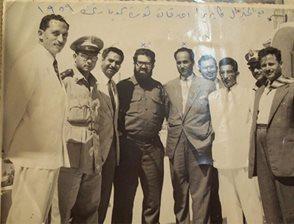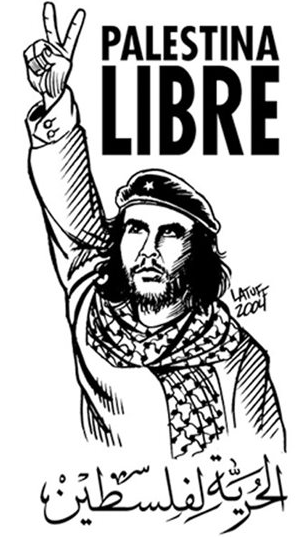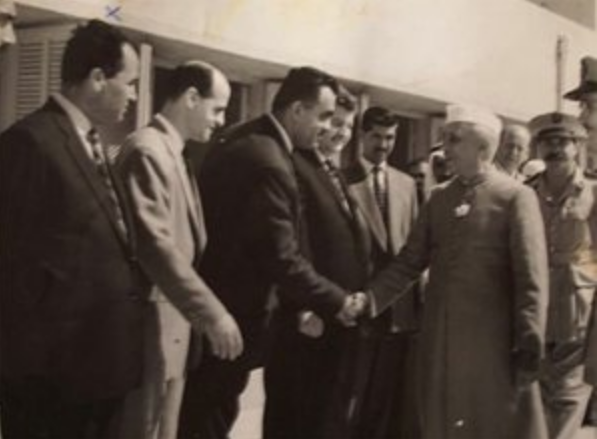
Che Guevara’s visit to Gaza in 1959 was the first sign of transforming the Zionist colonization of Palestine from a regional conflict to a global struggle against colonialism. The trigger was the Bandung conference in 1955 and the resulting Non-Aligned Movement, whose members has just recently shaken the yoke of foreign domination. The stature of Nasser, as a world leader in the struggle against Imperialism and colonialism, brought world leaders to see for themselves the devastating results of the ethnic cleansing of Palestine, clearly demonstrated in Gaza refugee camps.
Gaza Strip became the symbol of Palestine. This tiny sliver of land (1.3% of Palestine) remained the only place raising the flag of Palestine. It carried a major part of al Nakba burden when it became the temporary shelter for the inhabitant of 247 villages, expelled from their homes in southern Palestine. Villages in the south were ethnically cleansed by the Israeli military operation “Yoav”, also termed “The Ten Plagues”, in October 1948. Not a single Palestinian village remained. This act of total ethnic cleansing was propelled by several massacres which took place in Al Dawayima, Bayt Daras, Isdud, Burayr, among others.
Refugees, now corralled into Gaza Strip, were not immune from Israeli attacks even after their expulsion. The Majdal hospital was bombed in November 1948, as was the nearby al Joura village, which stood on the site of ancient Ashkelon and from which many future Hamas leaders would emerge. In January 1949, Israelis bombed food distribution centers in Dayr Al Balah and Khan Younis at peak hours, leaving over 200 bodies decimated by air raids. These raids led the usually restrained Red Cross to describe it as a “scene of horror”.
The occupation of Palestinian land and the expulsion of its population gave rise to a resistance movement, known then as the fedayeen. These resistance fighters crossed the Armistice line to attack the occupiers of their land.
In order to stop the incursions of the fedayeen and eliminate the idea of resistance, Israel continuously attacked the Gaza Strip refugee camps. In August 1953, Unit 101, led by Ariel Sharon, attacked Bureij refugee camp and killed 43 people in their beds. In August 1955, Israel, again led by Ariel Sharon, blew up the Khan Younis police station killing 74 policemen. In the same year, the Israelis killed 37 Egyptian soldiers in Gaza railway station and 28 others who were on their way to defend the others. The last attack changed the course of history in the region.
Egyptian president Gamal Abdel-Nasser, who assumed power in Egypt in July 1952, signed the first armament deal with the Soviet Block for arms denied to him by the British. He also authorised the fedayeen resistance by officially organising them under Colonel Mustafa Hafez.
On 29 October 1956 Israel invaded Sinai in collusion with Britain and France. The attacking Israeli soldiers entered Khan Younis on 3 November 1956, and collected all males between the ages of 15 and 50 from their homes and shot them in cold blood at their doorstep or against a wall in the town’s main square. The names of the 520 people killed have been listed. The following week, another massacre of refugees took place in Rafah. There were a deafening silence in the West about these massacres until the gifted cartoonist Joe Sacco immortalised them in his book Footnotes in Gaza.
These tragic events came to the world’s attention when Nasser became one of the recognised leaders of the Non-Aligned Movement starting with Bandung conference in 1955. Gaza Strip and Palestine came globally to light as the latest case of colonialism and ethnic cleansing.
 [Fig. 1]
[Fig. 1]
[Fig. 2]
As a result of this political develo]pment, Che Guevara, the Latin American revolutionary, came to visit Gaza Strip at Nasser’s invitation.
Guevara’s visit was momentous. It was the first time that a famous revolutionary comes to see the devastation created by Al Nakba first hand. He was met most enthusiastically by resistance leaders, such as Abdullah Abu Sitta, leader of the fedayeen (and leader of the southern front in the Arab Revolt of 1936, seen in [Fig-1], to the extreme right in Arab dress) and Qassem el Farra, third from right, Secretary of Khan Younis Municipality who kept records of fedayeen and their activities. Both were members of Palestine Legislative Council.
According to evidence I received from contemporaries about the visit, Guevara told Palestinian refugees they must continue the struggle to liberate their land. There was no way but resistance to occupation, he said. He admitted that their case was “complex” because the new Jewish settlers occupied their homes. “The right must eventually be restored”, he affirmed. He offered to supply arms and training but Castro wanted this aid to be coordinated through Nasser.
Mustafa Abu Middain, Al Bureij camp leader, took Guevara to visit the camp and showed him cases of poverty and hardship. “We have worse case of poverty”, Guevara shot back. “You should show me what you have done to liberate your country. Where are the training camps? Where are the factories to manufacture arms? Where are people’s mobilisation centres?”

Guevara was accompanied by General Caprera, an expert in Guerilla warfare. Caprera [Fig-2, with the beard] met with community leaders to advise on methods of resistance. Guevara became the icon of Palestinian resistance and struggle for freedom.[Fig-3]

Nasser took great interest in Guevara’s visit. He met him in his office, took him to public and official functions, introduced him to community leaders and presented him with medals [Fig-4, composite photo]. That was the start of very close relationship of revolutionary Latin America with Nasser and the Palestinians till this day.
After the visit, Cuba gave scholarships to Palestinian students, granted citizenships for stranded Palestinians and held many conferences in support of Palestine.
During the Israeli war on Gaza in the summer of 2014 Cuba sent tons of humanitarian aid to Gaza and received the injured. The support spread to most Latin American countries. El Salvador, Chile, Ecuador, Peru and Brazil have all withdrawn their ambassadors from Israel in protest. Bolivia’s President Evo Morales labeled Israel a “terrorist state” and restricted the entry of Israelis into the country. President Nicolás Maduro of Venezuela “vigorously condemned the actions of the illegal state of Israel against the heroic Palestinian people”. Nicaragua Solidarity Campaign with Palestine was very vocal both in the official and popular fields. The presidents of Uruguay, Brazil, Argentina and Venezuela issued a joint statement calling for a cessation of violence and an end to the Israeli blockade of Gaza Strip.

In the 1950s, Guevara was not the only well known personality of the Non-Aligned Movement to endorse the rights of Palestinians in a free Palestine. Jawaharlal Nehru, Prime Minister of India, also, came to visit Gaza in the same period [Fig-5]. That was the start of close Indian and other Asian support for Palestine.
Today Palestine is the symbol of the struggle of liberation from the last and longest colonial project. That is why over three quarters of the world countries support Palestine in the United Nations. Those few who did not are the remnants of the old colonial Western countries which created the colonial project in Palestine in the first place.